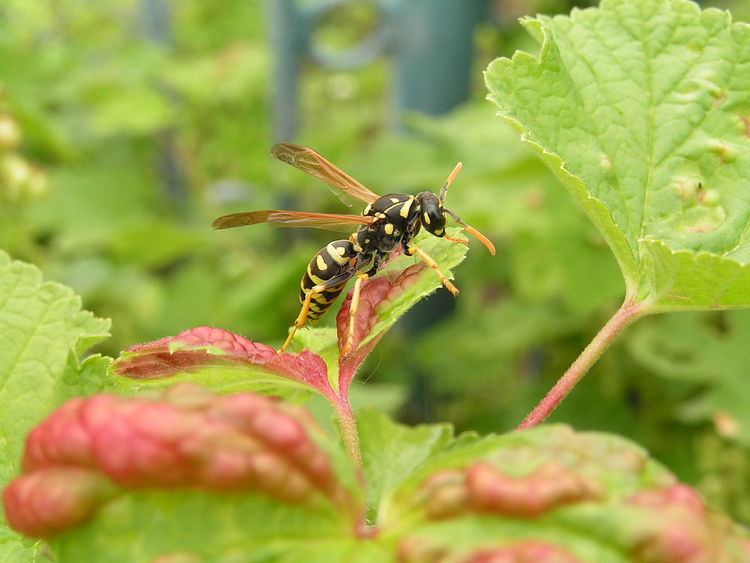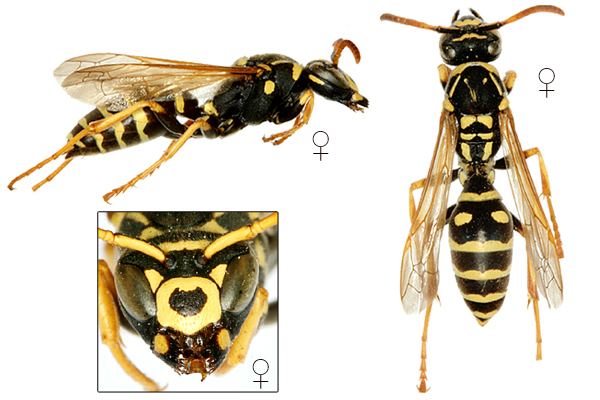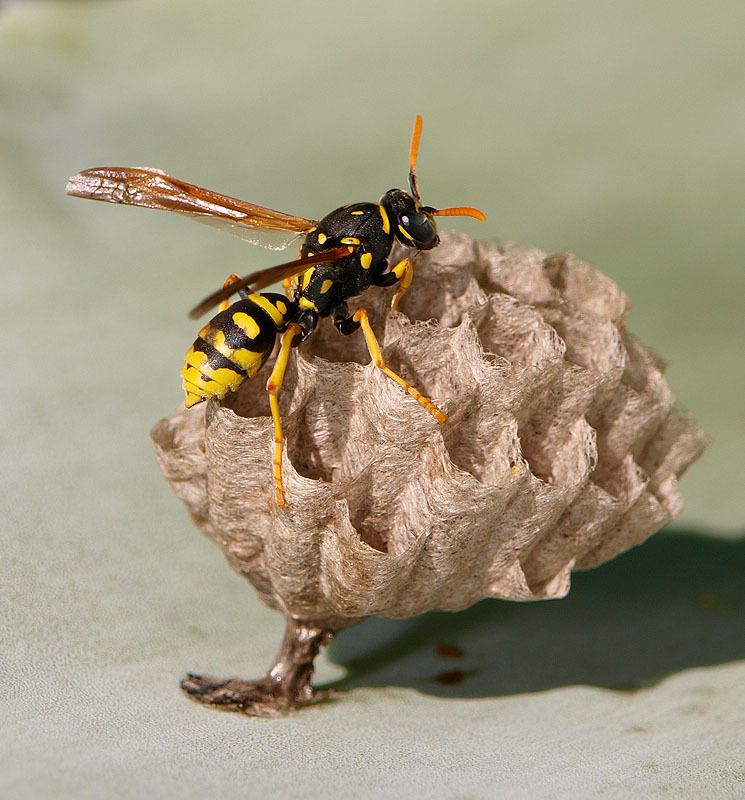Rank Species | Higher classification Polistes | |
 | ||
Similar Polistes, Insect, Vespidae, Polistes dominula, Hymenopterans | ||
Micro ct study of the common european paper wasp polistes gallicus high definition
Polistes gallicus (also historically referred to as Polistes foederatus) is a fairly common species of paper wasp found in various parts of Europe, excluding England, Denmark, and Scandinavia, from warmer climates to cooler regions north of the Alps. The distribution of P. gallicus also extends into northern regions of Africa, Israel, Iran, and even parts of China and Russia. Nests of these social insects are created in these various conditions. The Polistes species uses an oral secretion to construct their nests, which consist of a combination of saliva and chewed plant fibers. This structural mixture physically protects the nest from various harsh elements and from weathering over time.
Contents
- Micro ct study of the common european paper wasp polistes gallicus high definition
- Poliste dominula polistes gallicus vespidae hymenoptera
- Description and identification
- Taxonomy and phylogeny
- Distribution and habitat
- Colony cycle
- Dominance hierarchy
- Reproductive suppression
- Genetic relatedness within colonies
- Kin recognition and discrimination
- Queens interest
- Workers interest
- Parasites
- Defense
- Gains from the study of Polistes venom
- References

Poliste dominula polistes gallicus vespidae hymenoptera
Description and identification

P. gallicus can be spotted due to its distinct markings of bright yellow and black. It is relatively small in size compared to other native Polistes species. Curled antennae are a common characteristic in the genus for males, despite being shorter in length in comparison to wasps of other species. Their faces are also completely yellow in color. This species of wasp feeds its brood after visiting numerous flowers, collecting nectar in addition to feeding them meat. Due to its dimensions, they likely transfer pollen to the stigma, despite the fact that P. gallicus bodies are almost bald, which leads to few or no pollen grains stuck on them after foraging. This specific body type can help with identification.
Taxonomy and phylogeny

P. gallicus is a member of the Vespidae family, further classified under the Polistinae (the second-largest of the subfamilies) which consists of various social wasps. Within the larger subfamily Polistnae, Polistes species are categorized by their independent founding behavior, distinguishing them from swarm-founding species. P. gallicus is almost indistinguishable from the European paper wasp, P. dominula, with which it had long been confused. Nearly every reference to P. gallicus prior to 1985 was actually referring to P. dominula; due to the great similarity between species, however, many published studies for which no vouchered reference specimens are available cannot be reliably assigned to either species. Most of the literature that pertains to actual P. gallicus uses the junior synonym, P. foederatus, a name which still occasionally appears in the literature despite the known error. It is also closely related to P. biglumis and P. hellenicus
Distribution and habitat

The extensive range of P. gallicus includes a variety of climates and habitats, although ideally it prefers to nest in warm and dry areas. In Italy, nests are typically built in open areas hanging from branches with the cells opened towards the ground. In the colder conditions north of the Alps, metal scraps such as pipes serve as protective enclosures to P. gallicus nests. These wasps are the most widely distributed Polistes in Spain. P. gallicus also inhabits parts of Paris, although the farther north, the more rare this species becomes. Its conservation status in general has not been evaluated yet, although in its inhabited regions, it is common.

Nest structure can consist of numerous cells, with some nests containing as many as 500 cells. These nests are constructed from a mix of oral secretions and plant fibers to make a paper pulp. Bigger nests are more commonly found in southern regions. For example, a study of two wasp nests in Cambridge, Massachusetts, found a nest constructed inside a stop sign pole that was 8 cm high and 5 cm wide and consisted of 134 cells. A second nest, that contained 153 cells within the same nest dimensions, was found suspended from a pipe. The nests of P. gallicus tend to be smaller than those of comparative Polistes. Nest size also depends on the location, with nests in more sheltered areas tending to be larger.
Colony cycle
In the spring, wasps come out of hibernation and several foundresses (potential reproductive females) form nests together. This group effort is not always the case, as nests with multiple founders can be found in southern regions of Germany and in Italy. Most P. gallicus colonies in Germany, as well as in other northern areas nearby, are initiated by a single foundress. In Africa when the reproductive female leaves the nest, accompanied by several other workers, reproduction can occur by swarming. The cells formed are usually in a hexagonal pattern. The foundress then proceeds to lay eggs directly in the brood cells that are guarded by the foundress and subordinates. The newly hatched larvae are fed throughout their development, and each of the season’s first brood of wasps is exclusively female. These new members of the nest are given worker positions and serve as subordinates to the foundress.
In early summer, the first workers emerge, attending to duties such as maintaining the nest and taking care of the brood inside. The females that were assisting in the spring are usually driven off by the foundress at this time, and leave the nest, making room for the new additions. The reproductive phase follows when the female reproductives emerge. Male reproductives then emerge, leading to the start of the intermediate phase. Worker numbers start dropping due to a decline in brood care as the older individuals start dying and replacements no longer exist.
Dominance hierarchy
Hormones play a role in the establishment of dominance hierarchies among P. gallicus. Dominant females tend to have more developed ovaries due to higher activity levels in their endocrine systems. A larger corpora allata also influences the determination of dominance. A higher reproductive capacity is indicative of the dominant female.
Reproductive suppression
After a hierarchy is established, the dominant wasp remains the sole reproducer in the colony due to the inhibition of endocrine activity within the subordinate wasps. Various factors contribute to the possibility of inhibition, which might also lead to differences in endocrine activity. If subordinates happen to lay eggs after the hierarchy is formed, the dominant foundress will eat the eggs to ensure all laid eggs are of her own genes.
Genetic relatedness within colonies
Colonies of P. gallicus have one queen that mates and produces offspring. All females, both workers and queens, are capable of producing male offspring, and have a genetic incentive to do so; mother-to-son relatedness is 1/2, while the relatedness of a worker to her brothers is 1/4. If the queen has only been mated once, then worker's relatedness to the male offspring of other workers is 3/8, meaning workers should favor male production by themselves and their sisters over production by the queen. However, in the case that the queen mates more than once, workers are actually more related to their brothers than compared to the offspring of other workers (a mixture of full and half sisters).
Kin recognition and discrimination
P. gallicus reacts to chemical signals within Van der Vecht (VVS) organ secretions. VVS was studied and found to be a composition of hydrocarbons. The exact mixture tended to vary among differing colonies and also between the queen and workers, demonstrating worker specificity. Due to the different composition of the VVS chemicals, workers are able to distinguish these differences and respond with varying degrees of aggressiveness to other wasps which also release these chemicals. These chemicals can allow the wasps to interpret these cues about the presence of a related queen in the colony. While workers are able to discriminate VVS of their own queen and other workers, they are also able to distinguish odors when secreted from alien individuals.
The foundress of the nest has unicellular glands associated with this organ that peaks in activity around the time when workers start emerging. These chemicals are also hypothesized to serve as repellent secretions to defend the nest before it is populated. Also beyond just serving as a means of communication, when the queen deposits VVS on the nest during a particular stroking behavior of the queen, this serves as an indication of ownership tied to the presence of this particular queen. It actually has an inhibitory effect on the ovarian development of other workers within the colony.
Queen's interest
Due to the differences in relatedness within colonies, conflict over sex ratio arises. It would be beneficial for the queen to produce an equal ratio of sons and daughters due to equal relatedness between genders. Fisher’s theory of equal investment supports this 50:50 sex ratio of males and females. This is a stable situation, as both males and females have the same expected reproductive success. To maintain balance, queens may eat other workers' laid eggs if she was not successful in preventing workers from laying eggs in the first place.
Workers' interest
For workers, the production of males by the queen would be more favorable than to let other workers produce progeny. This would lead to an increased relatedness around 3/4, compared to the relatedness of worker produced males which is around 2/5. This might support the worker policing prediction that workers might prevent other workers from laying eggs in support of queen produced progeny when they are multiply mated. In addition, in colonies with the presence of a queen, workers will not produce males, but instead sacrifice their own interests for the greater good of colony productivity. Indirect evidence supports matricide within the colony, and queen death has been noted to be high in P. gallicus.
Parasites
Strepsipterans belonging to the genus Xenos are known to infect Polistes. Xenos vesparum has been especially documented in these wasps. Younger members of the colony are typically the target and most susceptible to parasitism. It is more difficult to document parasitized adult members due to their departure from the cell, which may play a role in perceived susceptibility. However, parasites are most visible in the neotenic adult or pupal stage. This does not distract from finding of strepsipteran parasites in all stages of the host, from egg, to larval, pupal, and finally the adult stage. Also, nests tended to have more parasites per brood member when parasite prevalence is high. Xenos species tend to infect these wasps either through phoretic transport in which the first-instar larvae are able to attach to wasps’ abdomens at flowering patches or by infecting masses by releasing close to combs from an infected wasp. Sometimes in brood with high levels of parasitized larval hosts, an adaptation of the parasite to enter the eggs might exist.
Defense
Polistes species are known to use stings and venom as a means of colony defense. However, this venom seems to be costly to produce as they only release it after the sting in certain situations. Dangerous stimuli must first be perceived before they go out of their way, leaving a nest unattended, to attack. In some situations, P. gallicus ise known to exhibit aggressive behavior to wasps of a foreign colony. While venom from a basic standpoint is used by solitary species to capture prey, it has served a greater purpose of defense in social colonies against colony vertebrate and invertebrate offenders.
When it comes to alarm systems, Polistes species can communicate with others through vibrational and visual signals. It might actually be beneficial for a smaller colony of wasps to switch from alarm pheromones, common with these wasps, to these alternative signals when the colony grows in size. Alarm pheromones mixed with the composition of the venom can also be released. However, if this release occurs following the act of ejecting venom by the signaling wasps or if it is due to the actual release of the venom during the sting has yet to be determined .
Gains from the study of Polistes venom
Knowing venom chemistry from these species of wasps can lead to human advantages for pharmaceuticals. The chemical breakdown of venom allows for synthesis in immunology therapy due to the creation of more reliable and effective treatments for people with allergies. Studies which analyzed the way venom interacts with victims provided a mechanism for drugs to permeate cell membranes. Further studies on wasps could provide a mechanism to control overpopulation through the creation of artificial sex attractants.
Allergic reaction-induced IgE-mediated anaphylaxis is commonly a result of hymenopteran stings. The composition of venom from a sting can even affect the types of treatment a patient should be given. Differences have been found between the composition of American and European Polistes venoms. Response to different epitope spectrums depends on the type of Polistes that did the stinging. P. gallicus venom was found to be a combination of four major allergens: Ag5 (antigen 5), hyaluronidase, phospholipase, and protease. This discovery has led to the addition of these allergens into a standard Polistes mix containing venom from North American species to improve diagnosis and therapy for European patients with Polistes allergies.
